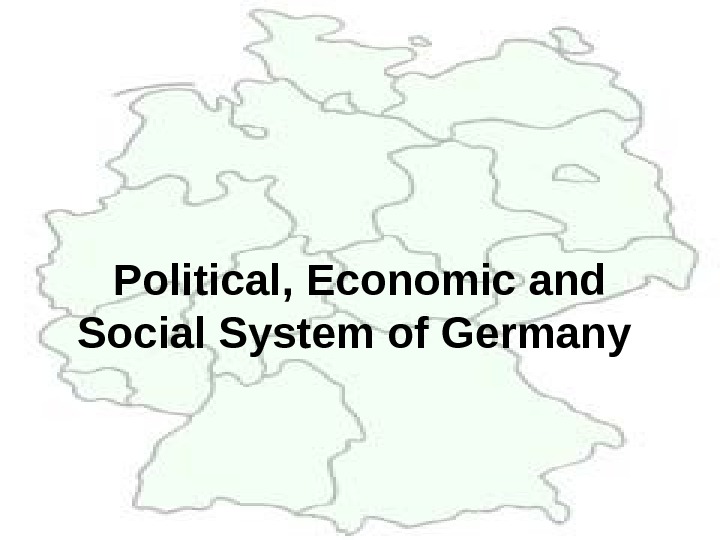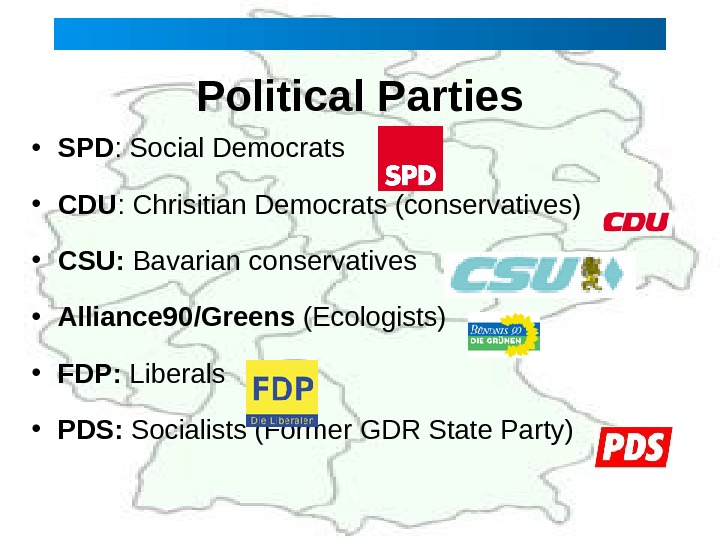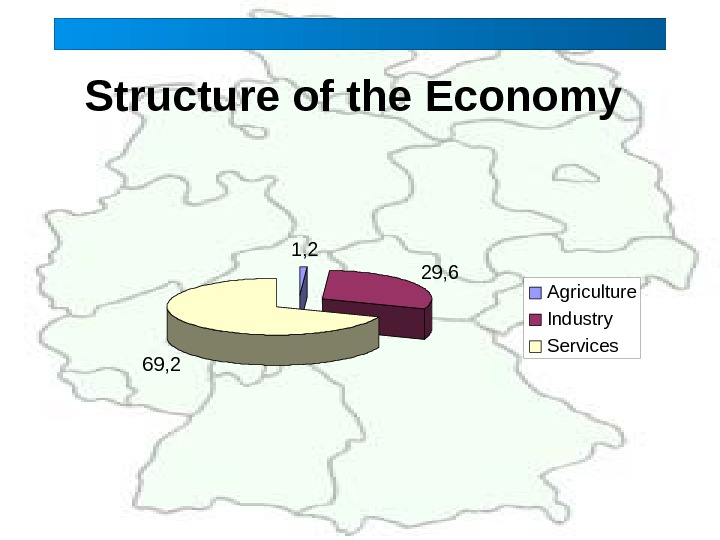Political, Economic and Social System of Germany






















- Размер: 504 Кб
- Количество слайдов: 21
Описание презентации Political, Economic and Social System of Germany по слайдам
 Political, Economic and Social System of Germany
Political, Economic and Social System of Germany
 Germany
Germany
 Basic Facts • Population: 82, 5 Million • Life expectancy: 78. 54 years • Area: 357, 021 sq. km • Ethnic background : German 91, 5%, Turkish 2, 4%, other 6, 1% • Religion: Protestant 34%, Catholic 34%, Muslim 3. 7%, unaffiliated or other 28. 3% • Human Development Index : 0. 925 (16)
Basic Facts • Population: 82, 5 Million • Life expectancy: 78. 54 years • Area: 357, 021 sq. km • Ethnic background : German 91, 5%, Turkish 2, 4%, other 6, 1% • Religion: Protestant 34%, Catholic 34%, Muslim 3. 7%, unaffiliated or other 28. 3% • Human Development Index : 0. 925 (16)
 History • 1871: Foundation of the German Reich • 1914 -1918: World War I • 1918 -1933: Republic of Weimar • 1933 -1945: Nazi Dictatorship and WW II • 1949: Foundation of the FRG and GDR • 1990: Reunification
History • 1871: Foundation of the German Reich • 1914 -1918: World War I • 1918 -1933: Republic of Weimar • 1933 -1945: Nazi Dictatorship and WW II • 1949: Foundation of the FRG and GDR • 1990: Reunification
 Political System • Germany is a federal, democratic and socially responsible state • Consists of 16 states (Länder) • Head of State: Federal President (Mostly representative) • Head of government: Chancellor
Political System • Germany is a federal, democratic and socially responsible state • Consists of 16 states (Länder) • Head of State: Federal President (Mostly representative) • Head of government: Chancellor
 Most Important Institutions • Bundestag (Parliament) • Bundesrat (Federal Council) • Federal Government • Länder (States)
Most Important Institutions • Bundestag (Parliament) • Bundesrat (Federal Council) • Federal Government • Länder (States)
 The Bundestag (Parliament) • Bundestag is the central institution of the political system with 603 members • Elected by all Germans for 4 years • Elects the Federal Chancellor, passes laws and controlls the government
The Bundestag (Parliament) • Bundestag is the central institution of the political system with 603 members • Elected by all Germans for 4 years • Elects the Federal Chancellor, passes laws and controlls the government
 The Bundesrat (Federal Council) • Representation of the Länder • Participates on the legislation • It is often used as a party-political instrument
The Bundesrat (Federal Council) • Representation of the Länder • Participates on the legislation • It is often used as a party-political instrument
 Federal Government • Formed by Ministers and the Chancellor • Chancellor determines „ policy guidelines “ • Normally formed by a coalition • Accountability to the Bundestag
Federal Government • Formed by Ministers and the Chancellor • Chancellor determines „ policy guidelines “ • Normally formed by a coalition • Accountability to the Bundestag
 Political Parties • » The parties shall help to form the political will of the people» (Article 21 of the Constitution) • 5% of the votes are needed to be part of the Bundestag
Political Parties • » The parties shall help to form the political will of the people» (Article 21 of the Constitution) • 5% of the votes are needed to be part of the Bundestag
 Political Parties • SPD : Social Democrats • CDU : Chrisitian Democrats (conservatives) • CSU: Bavarian conservatives • Alliance 90/Greens (Ecologists) • FDP: Liberals • PDS: Socialists (Former GDR State Party)
Political Parties • SPD : Social Democrats • CDU : Chrisitian Democrats (conservatives) • CSU: Bavarian conservatives • Alliance 90/Greens (Ecologists) • FDP: Liberals • PDS: Socialists (Former GDR State Party)
 Distribution of seats 15 th election period in the Bundestag
Distribution of seats 15 th election period in the Bundestag
 Self-government of the Länder • Länder are not Provinces • Responsible for the administration • Right to establish certain own laws • Subsidiarity principle
Self-government of the Länder • Länder are not Provinces • Responsible for the administration • Right to establish certain own laws • Subsidiarity principle
 Economy • Total GDP 2004: 2 177 Billion € • GDP per capita in 2004: 24. 000 € • Income /Employee 2004: 2200 €/ month • Total Exports in 2004: 730 Billion € • Unemployment 2004: 10, 4 %
Economy • Total GDP 2004: 2 177 Billion € • GDP per capita in 2004: 24. 000 € • Income /Employee 2004: 2200 €/ month • Total Exports in 2004: 730 Billion € • Unemployment 2004: 10, 4 %
 Structure of the Economy 1, 2 29, 6 69, 2 Agriculture Industry Services
Structure of the Economy 1, 2 29, 6 69, 2 Agriculture Industry Services
 Exports 0 10 20 30 40 50 60 70 80 France USA UKItaly. Netherlands Austria Spain. Switzerland China. Czech Rep. Billion Euro
Exports 0 10 20 30 40 50 60 70 80 France USA UKItaly. Netherlands Austria Spain. Switzerland China. Czech Rep. Billion Euro
 Unemployment per Region
Unemployment per Region
 Social System • Social Security : PAYG, financed by Employers and Employees, income related – Pension Insurance (19, 5%) – Health Insurance (12 -15%) – Long-term care Insurance (1, 7%) – Unemployment Insurance (6, 5%) • Social Assistance covering basic needs
Social System • Social Security : PAYG, financed by Employers and Employees, income related – Pension Insurance (19, 5%) – Health Insurance (12 -15%) – Long-term care Insurance (1, 7%) – Unemployment Insurance (6, 5%) • Social Assistance covering basic needs
 The Demographic Challenge
The Demographic Challenge
 Current Political Challenges • Global competition • Demographic changes • Unemployment • Public Deficit • Reactivating East Germany • Building a social Europe
Current Political Challenges • Global competition • Demographic changes • Unemployment • Public Deficit • Reactivating East Germany • Building a social Europe
 Thank you!
Thank you!

